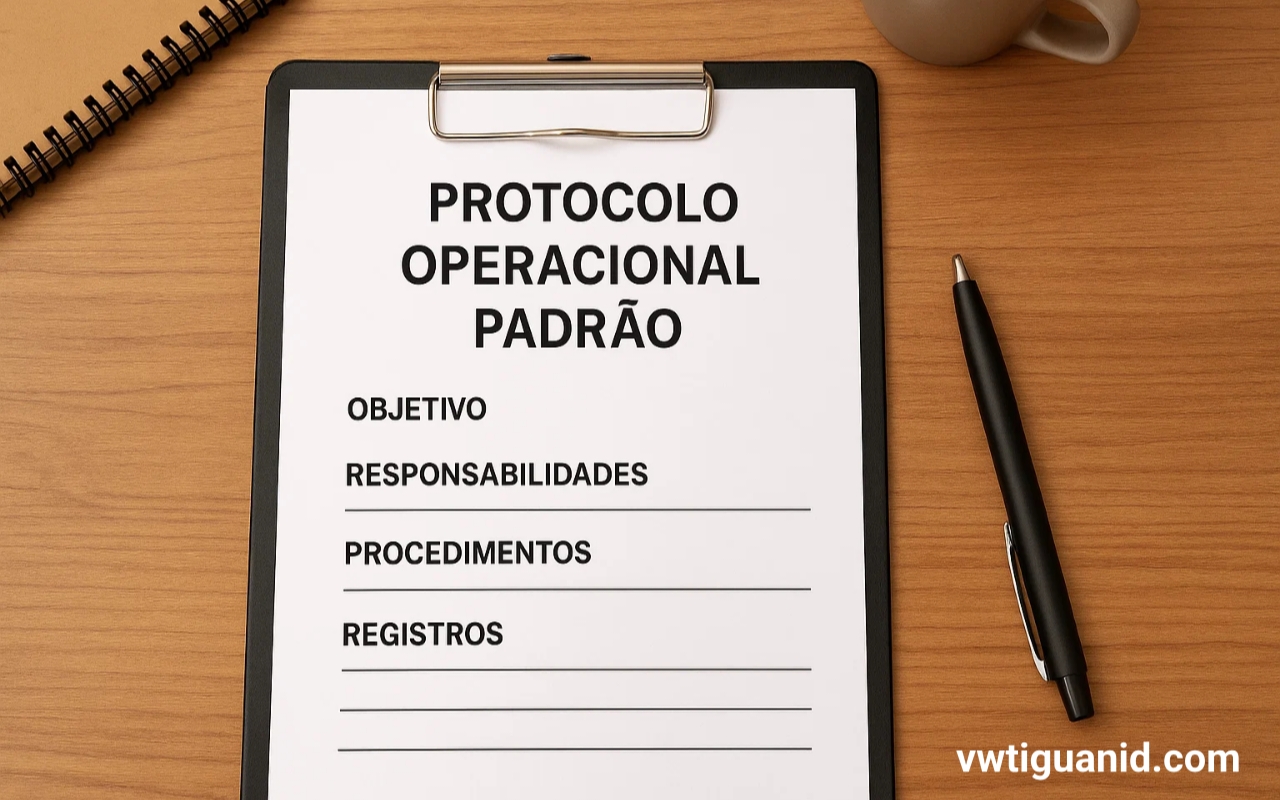Introduction
In a world where efficiency determines survival, companies can no longer afford the risk of leaving their processes to chance. Enter the Protocolo Operacional Padrão (POP)—the unsung hero of operational success. Whether you run a manufacturing plant, manage a health clinic, or operate a logistics company, having a well-crafted POP is like owning a GPS for your organization’s processes.
It ensures that everyone, from seasoned veterans to new hires, follows the same path to success. But here’s the catch: while many understand its value, few implement it properly. And fewer still know how to write one that truly serves the organization in real time. This guide breaks it down—not just what a POP is, but how to write one, implement it, optimize it, and most importantly, use it to drive lasting results.
What Is a Protocolo Operacional Padrão (POP)?
At its core, a protocolo operacional padrao is a standardized document that outlines the steps necessary to complete a specific task or process within an organization. Think of it like a flight manual for pilots or a recipe for chefs. Without it, you’re asking people to wing it—and in business, improvisation often leads to inconsistency, waste, and even disaster.
POPs serve as step-by-step guides that eliminate ambiguity, align team expectations, and foster a culture of precision and accountability. But it’s more than just instructions. A well-written POP becomes a living, breathing document that captures institutional knowledge, builds operational discipline, and serves as a blueprint for excellence.
When employees change, or teams scale rapidly, the absence of a protocol leads to knowledge gaps and reduced efficiency. But with a POP in place, processes are no longer reliant on individual memory or experience—they’re institutionalized, repeatable, and scalable.
In highly regulated industries, such as pharmaceuticals or aviation, having a documented POP isn’t just best practice—it’s legally required. Even in more flexible industries, such as IT or creative services, a POP ensures smooth onboarding, minimizes rework, and improves turnaround time. Simply put, it’s your secret weapon to scale without chaos.
Why Every Business Needs a Protocolo Operacional Padrão
Too many businesses operate like a game of telephone—each person passes on their version of how things should be done. Over time, those processes drift from the original, leading to inconsistent output, customer dissatisfaction, and avoidable errors. A protocolo operacional padrao stops that drift in its tracks. It acts as a single source of truth. Every time a process is followed using the POP, you’re reinforcing the standards your company has committed to.
But the benefits go beyond consistency. POPs also reduce training time for new employees. Imagine hiring someone and having to explain a task multiple times. With a well-documented protocol, they can learn on their own, revisit steps as needed, and ask smarter questions during training. It empowers employees to take ownership of their roles while reducing dependency on senior staff. Additionally, when something goes wrong—and it inevitably will—the POP allows you to audit the process itself rather than speculate. It’s a roadmap for troubleshooting.
In industries like healthcare or food production, having a POP isn’t optional. It’s a matter of safety and compliance. Without it, companies open themselves up to legal liability, failed audits, or even harm to clients and staff. In less-regulated spaces, POPs still provide strategic advantage. A software development team can avoid code conflicts. A marketing team can follow campaign launch procedures seamlessly. Across the board, a well-maintained protocolo is a powerful engine for quality assurance and process optimization.
Key Components of a Protocolo Operacional Padrão
To function properly, a protocolo operacional padrao must be built with precision. It should be structured in a way that is easy to understand, actionable, and specific to the task at hand. The best POPs are written in a language that’s both formal enough to be authoritative and clear enough for any staff member to follow without additional training. Let’s look at the most essential components.
First, begin with a title, objective, and scope. This helps readers immediately understand what the document is about, why it exists, and when it should be used. A strong objective sets the tone and ensures relevance. Next, list all necessary materials, tools, and resources. This prepares employees to perform the task without interruptions or delays, ensuring nothing essential is overlooked.
Then, lay out a step-by-step procedure in logical order. Each step should be clearly numbered or bulleted and include all relevant details, such as timing, safety measures, contingencies, and handoffs between departments. This section is the heart of your POP, and its clarity determines how useful the document will be.
It’s also critical to assign responsibilities and roles. Indicate who is responsible for performing each step, who verifies it, and who approves the results. This creates accountability and ensures proper oversight. Additionally, include a glossary of terms or acronyms, especially in technical fields, and finish with a section on document control—tracking version numbers, authorship, and approval signatures. This makes the document traceable and keeps teams aligned when changes are made.
How to Write an Effective POP From Scratch
Writing a POP is both an art and a science. It starts with a deep understanding of the task you’re trying to document. Don’t write it in isolation. Involve team members who regularly perform the task—they’ll help you identify edge cases, tricky parts, and shortcuts that formal guidelines may miss. Start by observing the process firsthand. Take notes, record timings, and ask open-ended questions. You’ll often discover that what seems like a five-step process is actually a ten-step one when done correctly.
Next, draft the document using simple, unambiguous language. Avoid corporate jargon or complicated phrasing. Use action verbs like “turn off,” “insert,” or “review.” Where appropriate, add flowcharts, images, or tables to visualize the process. These additions make the POP more accessible, especially for visual learners.
Once your draft is complete, test it in a real-world setting. Ask someone unfamiliar with the task to follow your instructions precisely. Did they succeed without confusion? If not, refine the language. After testing, review the document with supervisors or quality assurance teams to ensure accuracy and compliance. Only then should you approve and publish the POP, making it accessible in print and digital formats.
Avoiding Mistakes: Best Practices for POP Success
A major mistake companies make is treating the POP as a one-time effort. But your business evolves, and so should your protocols. Build a culture of regular review. Every six to twelve months, revisit each POP with its users. Ask what’s changed. Is the process still accurate? Could it be simplified? Is there a new tool in use that needs inclusion?
Also, ensure that every document follows a consistent structure. Uniform formatting improves usability and builds confidence in the content. Adopt mobile-friendly formats too. Many frontline workers access POPs via tablets or smartphones. If your document isn’t optimized for small screens, it won’t be used in practice, no matter how perfect it looks on a desktop.
Another trap to avoid is overcomplicating your protocols. Lengthy documents filled with unnecessary technical language or excessive legal clauses reduce readability. Your POP should be as concise as possible while still being complete. Remember: clarity is king.
POP in Practice: Real-World Examples
Let’s say you run a warehouse. One of your core processes is “Receiving New Inventory.” Your protocolo operacional padrao might look like this:
- Title: POP – Receiving and Logging Inventory
- Objective: To ensure all incoming goods are checked, documented, and stored efficiently.
- Scope: Applies to all deliveries received at the main dock from 8 AM to 5 PM.
- Steps:
- Inspect incoming shipment for external damage.
- Cross-check items against invoice and purchase order.
- Note discrepancies and report to procurement.
- Log all items into the inventory system.
- Label and move items to the designated storage area.
By documenting this process, your team can execute it smoothly, catch errors early, and maintain accurate records—all while onboarding new staff with ease.
How to Measure the Effectiveness of Your POP
So you’ve created a protocol—great. But is it working? Measuring POP effectiveness requires more than a gut feeling. Track key performance indicators (KPIs) such as compliance rates (how many employees follow it exactly), error reduction (before and after implementation), training time (how long it takes new hires to learn), and efficiency gains (is the task being done faster or with fewer steps?).
Gather feedback from users. Are they following the protocol? Do they understand it? Do they feel it adds value or slows them down? Their insights can guide updates and help you create a continuous improvement loop. Remember: the best POPs evolve. They get sharper with every revision.
Digital Tools and Templates for POP Creation
You don’t have to reinvent the wheel. Dozens of platforms offer free and premium POP templates, including Qualyteam, 8Quali, and Checklist Fácil. Use these as a starting point, then tailor them to fit your needs. Tools like Google Docs, Notion, and Process Street let you build dynamic, collaborative SOPs with version control, checklists, and real-time editing.
For larger organizations, integrating your protocols with a quality management system (QMS) offers even more power. These systems ensure compliance with standards like ISO 9001, make audit preparation easier, and provide analytics on protocol use and performance
Read More: vwtiguanid.com
Conclusion: Your Competitive Edge Starts Here
The protocolo operacional padrao is more than just a document. It’s a commitment to excellence, a blueprint for consistency, and a pillar of long-term success. By taking the time to craft, implement, and maintain strong POPs, you’re not just documenting tasks—you’re building a resilient, efficient, and scalable organization.
So don’t wait. Whether you’re a small business owner or a quality assurance manager at a multinational firm, your next move is clear: create your first POP or improve the ones you already have. Start small, test often, and refine with feedback. Because the sooner your processes are standardized, the sooner your business can grow—confidently and predictably.

